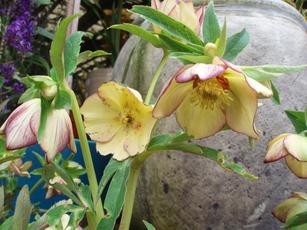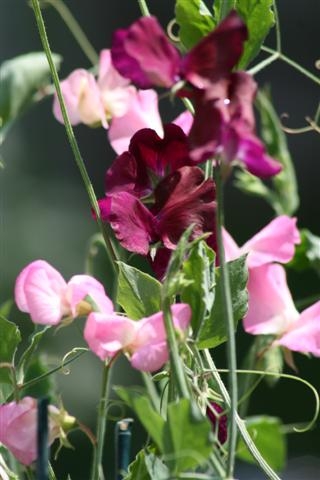I look out my window and see deep pink ruffled flowers covering my Blireiana flowering plum. It's one of my favorite early spring blooming plants and those fragrant blossoms are strong enough to scent my garden. It grows next to an Autumnalis flowering cherry that blooms nearly every month of the year. I'm not kidding. It's the energizer bunny of the flowering tree world. We all look forward to the earliest flowers of the new season. What else blooms in winter that you might want to have in your garden? Here are just a few suggestions.
One old fashioned shrub that figured prominently in many old gardens is forsythia. Deep golden-yellow flowers completely cover the bare stems in late winter and become the focal point of the landscape when in full bloom. The showy stems of this easy care shrub are great for cutting. Forsythias are native to eastern Asia but a chance discovery in Germany by a grower who specialized in breeding for the cut flower industry led to the especially vivid variety Kolgold in the 1800's. Forsythia has long been used in Chinese medicine. The flow er petals contain powerful bacteria-fighting properties which make it an important dressing.
er petals contain powerful bacteria-fighting properties which make it an important dressing.
Hellebores are another winter blooming plant that with foliage that looks great, too. My double purple one has been blooming for well over a month now. I've got my eye on a variety called Golden Sunrise. Each plant is different with variations of large, canary yellow flowers. Some are solid yellow but most have some degree of red veining and a red picotee edge. Some have a red starburst in the center. Hellebores bloom for six weeks or more and are deer and rabbit resistant. They are often flowering during the Christian season of Lent from which they get their common name, Lenten Rose. Use them for naturalizing in woodland areas. They are a low maintenance plant, will survive with little water and are disease and pest free.
What would a shade garden be without a bright orange clivia? Every year I look forward to their huge flower clusters to emerge from the dark green strappy leaves. Even in dark shade they will bloom and brighten the winter garden although they would do fine in morning sun. If you have a north facing window you can grow them as houseplants. Clivias are hardy to several degrees below freezing but mine, under an overhang, have survived temps of 23 degrees without damage.
Clivia breeders have produced gold and peach colored flowers also but I still like the standard orange and they didn't cost $599 like the plants I saw offered on the internet. I thought this price might have been a misprint but on further investigation I found another site offering the yellow Gloria clivia for a mere $950. I'll stick with my orange ones.
A beautiful vine that blooms in winter is Hardenbergia 'Happy Wanderer'. In the pea family, this evergreen vine looks like a small wisteria when in bloom. Pinkish purple flowers cascade in clusters on twining stems that reach 12-16 feet long. It requires little water once established and is hardy to about 23 degrees. If you have an older, tangled plant you can rejuvenate it with hard pruning in early spring after flowering. Never prune in late summer or fall because you will cut off the wood that is going to bloom the following winter.
The last plant I couldn't live without is Fragrant Sarcococca. The tiny flowers of this plant are easily overlooked but you can't miss their scent. If you have a problem spot in dry, deep shade give this plant a try. It's easy to grow, deer resistant and trouble free.

 Who doesn’t love old-fashioned sweet peas? A small bouquet will perfume a room with a delicious scent. They remind me of my Aunt Ruth who grew them every year and let me pick a bunch each spring whenever I went to visit. There are many new varieties and colors these days but back then her sweet pea vines were covered with the classic mixed colors of violet, blue, pink, peach and white.
Who doesn’t love old-fashioned sweet peas? A small bouquet will perfume a room with a delicious scent. They remind me of my Aunt Ruth who grew them every year and let me pick a bunch each spring whenever I went to visit. There are many new varieties and colors these days but back then her sweet pea vines were covered with the classic mixed colors of violet, blue, pink, peach and white.